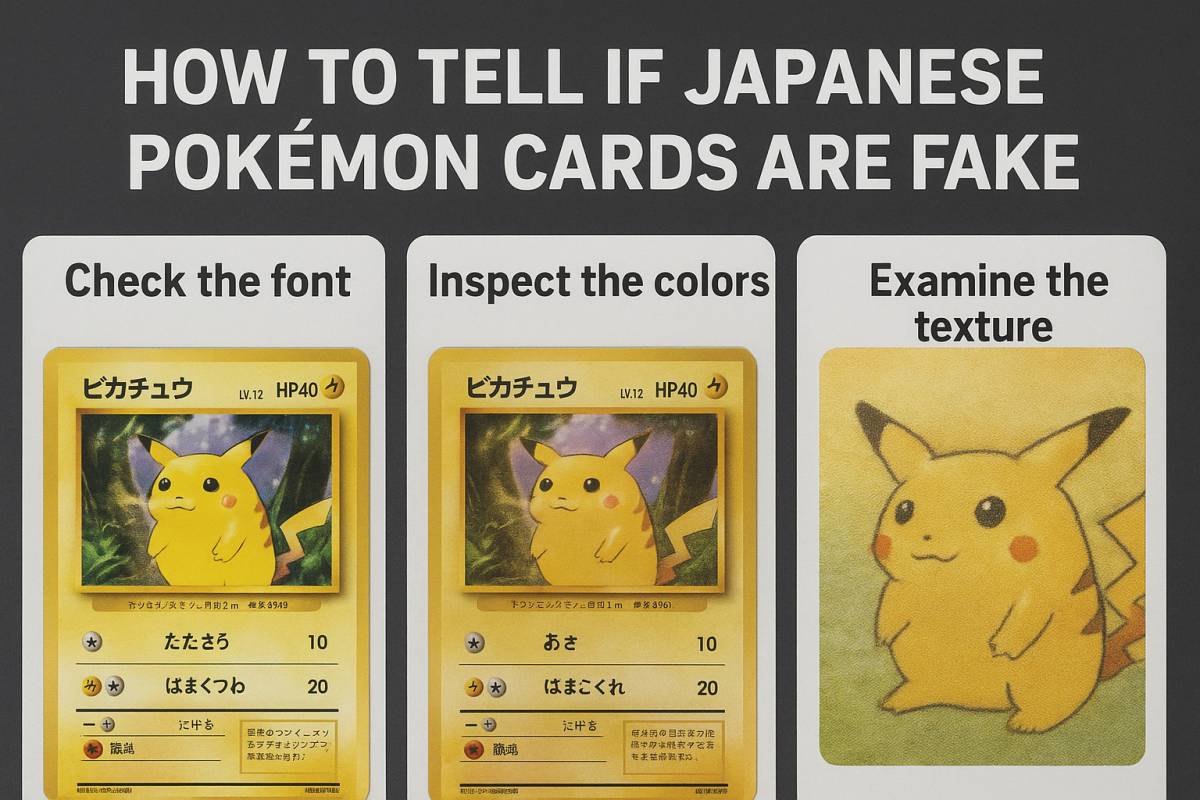How To Tell If Japanese Pokemon Cards are Fake

The easiest way to tell if a Japanese Pokémon card is fake is by looking at print quality, texture, and small details. Real cards have sharp artwork, smooth edges, and clear text, while fake ones often look blurry, feel flimsy, or show mistakes in spelling and design. Once you know what to look for, spotting a counterfeit becomes simple.
Let’s break it down step by step so you’ll never get tricked again.
Why Fake Japanese Pokémon Cards Exist
Pokémon cards are hugely popular, and Japanese editions are especially sought after because they often release earlier, include special promos, or have unique holofoil designs. Some rare cards can sell for hundreds—or even thousands—of dollars.
That kind of money attracts counterfeiters. They make cheap knockoffs and sell them online, hoping buyers won’t notice. The good news? With a few quick checks, you can avoid falling for a fake.
1. Look at the Card Back
Flip the card over.
- Real cards: The blue background is bold and rich, the gold “Pokémon” lettering is crisp, and the design is perfectly balanced.
- Fake cards: The colors look faded, the print is blurry, or the back feels “off”—too shiny or not shiny enough.
Pro tip: Compare the back of a suspicious card with one you know is real. The difference usually jumps out.
2. Check the Borders
Japanese Pokémon cards have clean, even borders.
- Real: Thin, smooth edges with consistent coloring.
- Fake: Uneven borders, faded edges, or sloppy cutting.
If the border looks unusually thick or the color feels wrong, that’s a warning sign.
3. Inspect the Text
Fonts are one of the biggest giveaways.
- Real cards: Japanese characters are sharp and evenly spaced. The English copyright text at the bottom is spelled perfectly.
- Fake cards: Blurry text, odd spacing, or misspelled words like “Pokeman” instead of Pokémon.
Even if you don’t read Japanese, you can spot poorly printed text.
4. Study the Holofoil
Shiny cards are the most faked, so look carefully.
- Real: Smooth, even holo patterns that shine naturally in the light.
- Fake: Overly glittery, dull, or “grainy.” Some even use a sticker instead of real holofoil.
If it looks too flashy or too flat, it’s probably fake.
5. Feel the Card
Touch matters more than you think.
- Real: Feels firm and slightly textured, with high-quality cardstock.
- Fake: Flimsy, too glossy, or too thick.
Try bending the card gently. Real ones bend back smoothly; fakes often feel weak or stiff.
6. Do the Light Test
Hold the card up to a bright light.
- Real cards: You won’t see light passing through easily because of the layered cardstock.
- Fake cards: Thin paper lets light shine right through.
This quick test works almost every time.
7. Check Set Symbols and Numbers
At the bottom corner of every card, you’ll find a set symbol and number.
- Real: Matches official Pokémon set checklists.
- Fake: Wrong symbol, missing number, or expansion names that don’t exist.
If you can’t find the card on official Pokémon sites or collector databases, that’s a big red flag.
Common Red Flags at a Glance
Here’s a quick checklist to remember:
- Blurry artwork or text
- Wrong card size
- Borders too wide or uneven
- Misspellings in copyright text
- Holo looks strange or fake
- Card feels flimsy or too thick
- Doesn’t appear in official card lists
What To Do If You Find a Fake
- Don’t resell it as real. That’s dishonest and can get you banned from marketplaces.
- Keep it as a reference. It helps to compare when checking future cards.
- Report the seller. If you bought it online, let the platform know.
- Buy smarter next time. Stick to trusted sellers, collectors, or shops with good reputations.
Final Thoughts
Spotting a fake Japanese Pokémon card isn’t as hard as it seems. Once you check the back design, borders, text, holofoil, and feel of the card, you’ll quickly know if it’s real or counterfeit. With practice, your eye will get sharper, and you’ll never waste money on a fake again.
Collecting Pokémon cards should be fun – and knowing the difference between real and fake keeps your collection valuable and authentic.









